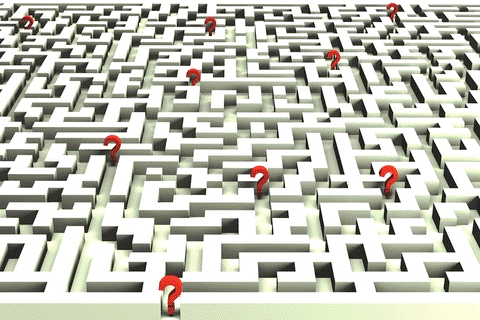Ambiguity causes anxiety in those who are inflexible, and creates possibilities in the minds of the people who have flexible focus.
But tolerance for ambiguity drops when you have to make a decision. Urgency adds pressure, and when the decision affects the core areas of your life, you can feel as if you are lost in a labyrinth of choices.

However, a labyrinth is only a mystery to those trapped within its walls. The way to free yourself from the trap is to gain a bird’s eye perspective, which helps you see where you are now, and how to find your way out.
Decision is a strong word, a choice, a judgment, a commitment to a purpose. Decisiveness is a quality of successful people, who make decisions quickly and change their minds slowly. This enables them to take advantage of opportunities that are missed or go unnoticed by those who take a long time to make a decision, and then easily change their minds.
Your decision sets the wheels in motion, whereas with indecision the wheel turns without you. This insight is the origin behind such sayings as,he who hesitates is lost, and strike while the iron is hot. As long as you are in motion you can steer the vehicle. The moment you stop moving you start to drift, and are at the mercy of the elements.
Opportunities come in critical moments
So says Roger Hamilton, author of Your Life Your Legacy, who compares decision making with what you do the moment the soccer ball is passed to you. Depending on your position on the pitch and who is around you, you may pass, run with, or kick the ball. If you hesitate then the ball, and the opportunity, will be taken away from you.
Roger also recommends Six Criteria for Decision Making, which can keep you moving in the right direction.
1.Fits Passion and Purpose
2.Allows Value Creation
3.Allows Leverage
4.Failure steers not sinks
5.Downside learning motivates
6.Upside learning inspires
When faced with an important decision in your career, the alternatives usually contain some attractive elements mixed in with other elements that make you hesitate. The temptation is to compromise and take what you can get, rationalizing that no option will be perfect. However, if you disregard an important element now, it will eventually come back and cause you to regret or revise your decision.
If you can align all six of the decision criteria, then you are already out of the labyrinth.
Learn from others with a better perspective
A great way to gain perspective is to gather quotes from people who have wisdom and experience with decisions. You can search famous quotes online using key words such as decisions, dilemma, choices, or whatever word works best for you.
Here are some quotes that I searched and selected using the word decisions.
•Pressure is nothing more than the shadow of great opportunity. (~Michael Jordan)
•It is never to late to be what you might have been. (~George Eliot)
•You will always miss 100% of the shots you don’t take. (~Wayne Gretsky)
•It’s not hard to make decisions when you know what your values are. (~Roy Disney)
•Life is the sum of all of your choices. (~Albert Camus)
•Indecision becomes decision with time. (~Unknown)
•Once you make a decision, the universe conspires to make it happen. (Ralph Waldo Emerson)
•Fortune favors the prepared mind. (~Louis Pasteur)
When you face an important decision that does not easily yield to logical choices, place your favorite quotes on a Mandala Chart and use them as a tool for accessing the best perspective on your decision. You can download a PDF featuring the quotes above as a DECISION MANDALA for practice, and then create your own.
This is quick way to create a roundtable of advisors to help you with your decision, a portable mastermind that costs nothing and transcends time and space. The process of collecting the quotes helps you refine your criteria, and the time spent looking at the quotes in the Mandala Chart format brings things into sharper focus.
You can apply the same process working with decision criteria. Eight criteria should be enough for most situations. The Mandala Chart can be useful as a self-coaching tool, or to organize your thoughts before seeking outside advice. It can sort through the insignificant many, and give you a field of focus for the significant few.
Making better decisions
How do you make good decisions when the choice is not easy?
Do you list the advantages and disadvantages of each alternative? A good beginning, but it is often hard to weigh emotions and intangibles.
Do you consult with your friends? Nice to have moral support, but friendly advice can end up making you more confused than ever. Advice is cheap, and none of people you ask are likely to have as much invested in the outcome as you do.
Do you gather more information? Worthwhile to a point, but too much analysis leads to decision paralysis.
Do you flip a coin? Consult an oracle? Ultimately the decision will be back to you.
The only way to get clarity on a decision is to reflect on it with a calm mind and a broad perspective. The Mandala Chart can help you do this.
The quality of your decisions determines whether they become traps or opportunities.


